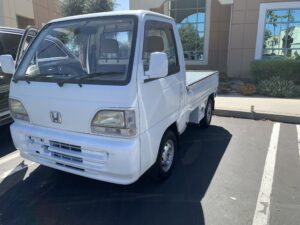
This 1998 Honda Acty VIN Verification was done by our team member in Lake Forest, Ca. on
10-08-2024

This 1998 Honda Acty VIN Verification was done by our team member in Lake Forest, Ca. on
10-08-2024
The 1998 Honda Acty is a kei truck (light truck) and microvan designed for the Japanese domestic market, catering to small business owners, urban delivery drivers, and farmers. The Acty is known for its compact dimensions, fuel efficiency, and versatile cargo capabilities, making it ideal for navigating narrow city streets or rural environments. As part of the kei car class, it adheres to strict regulations on size and engine displacement to offer tax and insurance benefits in Japan.
The Honda Acty was first introduced in 1977 as Honda’s entry into the kei truck and van market, replacing the Honda TN series. It was designed to meet Japan’s kei car regulations, which limit engine displacement and vehicle size. By 1998, the Acty was in its third generation, introduced in 1994, with continued updates to its design and performance. The Acty was primarily marketed in Japan, although it gained popularity in other countries as a gray-market import due to its practicality and efficiency.
The 1998 Honda Acty is powered by a small, efficient engine that adheres to kei car regulations:
With a focus on utility rather than performance, the Acty’s small engine is designed for short-distance hauls and light payloads, making it perfect for small businesses and personal use.
The 1998 Honda Acty has a compact, functional design, emphasizing utility and efficiency.
The 1998 Honda Acty was available in several configurations to suit different needs:
As a small kei truck, the 1998 Honda Acty did not have the advanced safety features found in larger or more modern vehicles. However, it provided basic safety and reliability for its class:
The 1998 Honda Acty excels in fuel efficiency, a key selling point in the kei car segment:
The compact size and lightweight design further contribute to its excellent fuel economy, which is a key advantage for small business owners and urban drivers.
In the kei truck and van market, the Honda Acty faced competition from other Japanese manufacturers, such as:
Each model offered similar benefits, with the Honda Acty standing out for its durable engineering and strong brand reputation.
In 1998, the Honda Acty was priced affordably to meet the needs of budget-conscious buyers, with prices starting around:
While the Honda Acty did not receive major industry awards, it gained a reputation for its practicality, reliability, and cost-effectiveness, especially in the Japanese domestic market. Its simplicity and versatility have earned it a loyal following among businesses and individuals needing a compact, economical vehicle for light-duty tasks. The 1998 model year is particularly valued by collectors and enthusiasts for its durability and classic kei truck design.
Need a VIN Verification? We are licensed to complete the REG 31 form. Call to get your car, truck or motorcycle verified today!
© 2025 QUICK VIN VERIFICATION. All rights reserved.